-
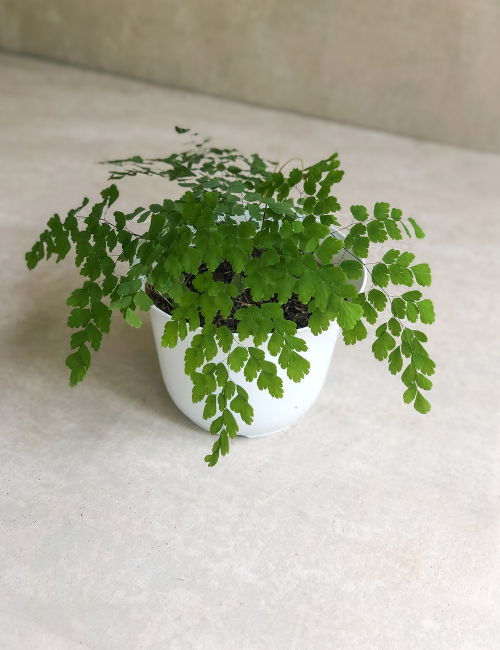 Maidenhair Fern. Maidenhair ferns have delicate fan-shaped leaf segments, typically clustered on wiry black stems. In addition to being a popular houseplant, maidenhair fern can also be found in nature, growing in places where other plants typically don't, like on rock walls and in between rock fissures where the moisture from water seepage keeps them alive. Prefers bright indirect light, avoid harsh direct sunlight that may burn your plant’s leaves. 2-3 times a week. Water sparingly, making the potting mixture barely moist and allowing the top third to dry out before watering again.
Maidenhair Fern. Maidenhair ferns have delicate fan-shaped leaf segments, typically clustered on wiry black stems. In addition to being a popular houseplant, maidenhair fern can also be found in nature, growing in places where other plants typically don't, like on rock walls and in between rock fissures where the moisture from water seepage keeps them alive. Prefers bright indirect light, avoid harsh direct sunlight that may burn your plant’s leaves. 2-3 times a week. Water sparingly, making the potting mixture barely moist and allowing the top third to dry out before watering again. -
 Calathea Ctenanthe Burle Marxii Amabilis The Peacock plant has large light glossy green leaves with dark green veins and blotchy patterns. The attractive foliage has a pattern reminiscent of a peacock’s tail feathers. New leaves grow rolled up exposing the purple colour underside. Calathea plants need bright, but not direct, sunlight to grow. This is because they grow on the floor of jungles and forests where they get limited light through the tops of the trees. In fact, direct sunlight will burn the leaves of a Calathea plant and cause it to lose its vibrant colors. 2-3 times a week, Calathea like to have moist soil or planting substances, but not soggy. They do not want lots of water.
Calathea Ctenanthe Burle Marxii Amabilis The Peacock plant has large light glossy green leaves with dark green veins and blotchy patterns. The attractive foliage has a pattern reminiscent of a peacock’s tail feathers. New leaves grow rolled up exposing the purple colour underside. Calathea plants need bright, but not direct, sunlight to grow. This is because they grow on the floor of jungles and forests where they get limited light through the tops of the trees. In fact, direct sunlight will burn the leaves of a Calathea plant and cause it to lose its vibrant colors. 2-3 times a week, Calathea like to have moist soil or planting substances, but not soggy. They do not want lots of water. -
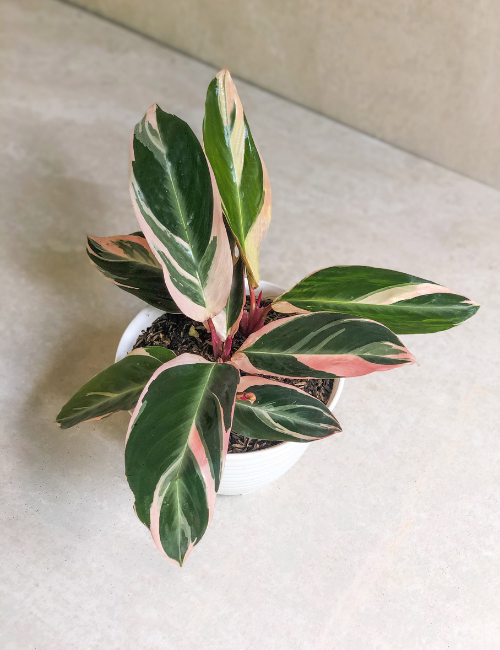 Calathea Stromanthe Triostar. The Stromanthe Triostar is one of those sensational, star-quality plants you fall in love with immediately. Its artistically splashed green-and-white foliage glows with pinkish hues will add extra colours to your home. Prefers bright indirect light, avoid harsh direct sunlight that may burn your plant’s leaves. Water about once a week (or more often if environment is very warm) to keep soil evenly moist but never soggy. Mist between watering to provide humidity.
Calathea Stromanthe Triostar. The Stromanthe Triostar is one of those sensational, star-quality plants you fall in love with immediately. Its artistically splashed green-and-white foliage glows with pinkish hues will add extra colours to your home. Prefers bright indirect light, avoid harsh direct sunlight that may burn your plant’s leaves. Water about once a week (or more often if environment is very warm) to keep soil evenly moist but never soggy. Mist between watering to provide humidity. -
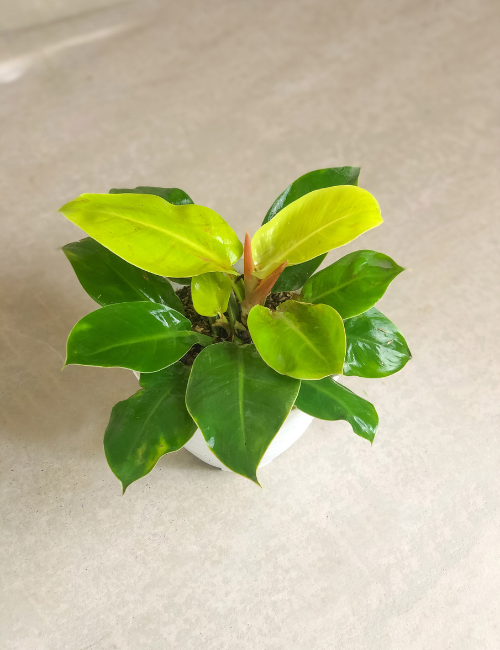 Philodendron Moonlight. This evergreen, clumping cultivar goes by the common name lime Philodendron. Why? Its leaves, and new growth sport a bright yellow-green chartreuse color. This color barely fades over time. Bright partial shade or indirect light will ensure a happy moonlight Philodendron. 2 to 3 times a week. If the soil is nearly dry, water it don't let the soil dry out entirely.
Philodendron Moonlight. This evergreen, clumping cultivar goes by the common name lime Philodendron. Why? Its leaves, and new growth sport a bright yellow-green chartreuse color. This color barely fades over time. Bright partial shade or indirect light will ensure a happy moonlight Philodendron. 2 to 3 times a week. If the soil is nearly dry, water it don't let the soil dry out entirely. -
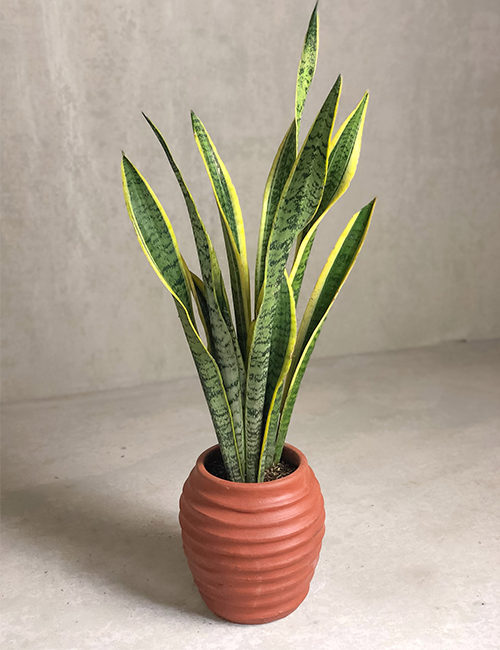 Sansevierias (Snake Plants) are some of the toughest plants you can find. Whether indoors, in your garden or on your balcony, these spiky beauties can put up with almost anything. Sansiviera prefer bright, indirect light and can even tolerate some direct sunlight. However, they also grow well (albeit more slowly) in shady corners and other low-light areas of the home. 3 -5 times a week depends on humidity of your room, please make sure to touch the soil before you water it.
Sansevierias (Snake Plants) are some of the toughest plants you can find. Whether indoors, in your garden or on your balcony, these spiky beauties can put up with almost anything. Sansiviera prefer bright, indirect light and can even tolerate some direct sunlight. However, they also grow well (albeit more slowly) in shady corners and other low-light areas of the home. 3 -5 times a week depends on humidity of your room, please make sure to touch the soil before you water it. -
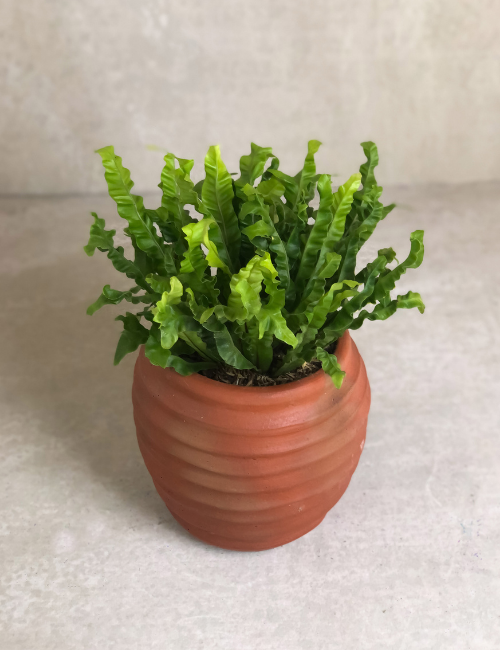 Asplenium Lasagna in Honey Bee Terracotta. Known as Kadaka Lasagna in Indonesia this plant is a favourite because its very wiggle-edged lush fern for tropical gardens and indoor decor - plant it somewhere shady and moist and watch it unfurl. No direct sunlight Only after Soil dries completely
Asplenium Lasagna in Honey Bee Terracotta. Known as Kadaka Lasagna in Indonesia this plant is a favourite because its very wiggle-edged lush fern for tropical gardens and indoor decor - plant it somewhere shady and moist and watch it unfurl. No direct sunlight Only after Soil dries completely -
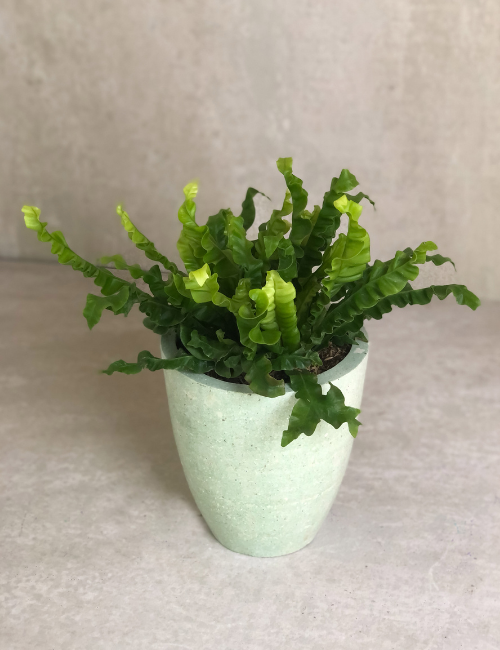 Asplenium Lasagna in Emerald Terrazzo. Known as Kadaka Lasagna in Indonesia this plant is a favourite because its very wiggle-edged lush fern for tropical gardens and indoor decor - plant it somewhere shady and moist and watch it unfurl. No direct sunlight Only after Soil dries completely
Asplenium Lasagna in Emerald Terrazzo. Known as Kadaka Lasagna in Indonesia this plant is a favourite because its very wiggle-edged lush fern for tropical gardens and indoor decor - plant it somewhere shady and moist and watch it unfurl. No direct sunlight Only after Soil dries completely -
 Begonia Malculata. Begonia maculata, or Polka Dot begonia as it’s often called, is a splashy show-stopper that looks fantastic with it’s olive green leaves and contrasting spots. It’s a houseplant that is likely to turn heads in your home, and thankfully it isn’t too difficult to care for. Bright, indirect light. Higher light levels will promote strong growth and blooms, but avoid direct sunlight Keep the soil generally moist, letting the top half inch of soil dry out between watering. Will not tolerate soggy soil.
Begonia Malculata. Begonia maculata, or Polka Dot begonia as it’s often called, is a splashy show-stopper that looks fantastic with it’s olive green leaves and contrasting spots. It’s a houseplant that is likely to turn heads in your home, and thankfully it isn’t too difficult to care for. Bright, indirect light. Higher light levels will promote strong growth and blooms, but avoid direct sunlight Keep the soil generally moist, letting the top half inch of soil dry out between watering. Will not tolerate soggy soil. -
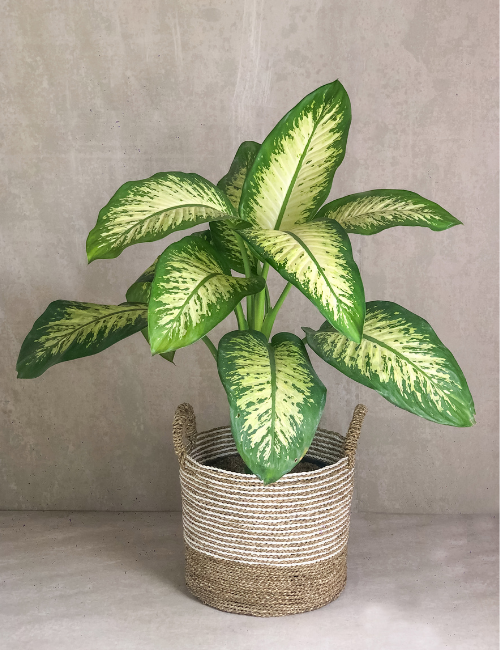 Dieffenbachia Seguine 'Tropic Snow'. Everything about the dumb cane, or dieffenbachia, is dramatic. Native to the tropics of Central and South America, it has huge variegated leaves. Even the way it grows is showy, new leaves curling up from the central stem before they unfurl. Price exclude basket. Diffenbachia likes a good amount of light throughout the day, but ideally not direct sunlight. 2-3 times a week. Water sparingly, making the potting mixture barely moist and allowing the top third to dry out before watering again.
Dieffenbachia Seguine 'Tropic Snow'. Everything about the dumb cane, or dieffenbachia, is dramatic. Native to the tropics of Central and South America, it has huge variegated leaves. Even the way it grows is showy, new leaves curling up from the central stem before they unfurl. Price exclude basket. Diffenbachia likes a good amount of light throughout the day, but ideally not direct sunlight. 2-3 times a week. Water sparingly, making the potting mixture barely moist and allowing the top third to dry out before watering again. -
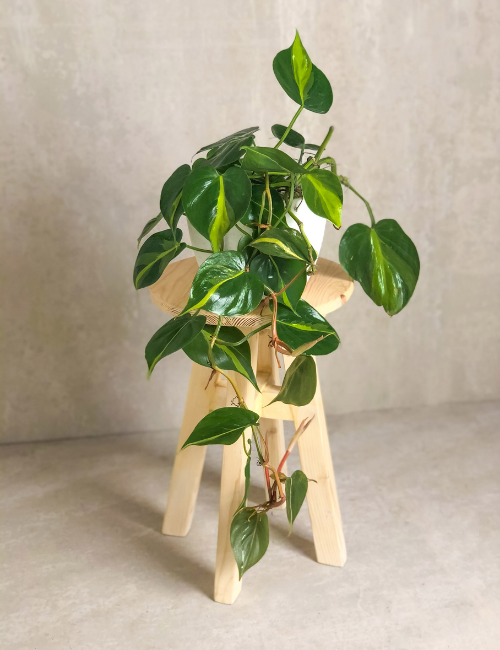 Philodendron Hederaceum 'Brasil'. Philodendron hederaceum 'Brasil' is a wild and bold cultivar of the classic Heartleaf Philodendron. Its variegated leaves look almost painted, with strokes of yellow and lime green across the deep green foliage. Low to bright, indirect light. 2-3 times a week. Water sparingly, making the potting mixture barely moist and allowing the top third to dry out before watering again.
Philodendron Hederaceum 'Brasil'. Philodendron hederaceum 'Brasil' is a wild and bold cultivar of the classic Heartleaf Philodendron. Its variegated leaves look almost painted, with strokes of yellow and lime green across the deep green foliage. Low to bright, indirect light. 2-3 times a week. Water sparingly, making the potting mixture barely moist and allowing the top third to dry out before watering again. -
 Anthurium Laceleaf. The red oval spathes of a flamingo flower & Laceleaf make it really distinguishable. The flowers grow on orange spadix and grow densely. The heart-shaped flowers are actually morphed leaves and called spathes. The lifeline of spathes is about 8 weeks. The flowers are small in size and perfect in shape, hence, are deemed to be true flowers. The leaves of this flower can grow up to 18 cm long and twirl around the main stem. Indirect bright light is best for your plants. If you want your Anthurium plant to thrive and bloom properly, that’s the way to go about. In the absence of proper light, the plant can become spindly as it tries to reach out for light. Please note that anthurium requires indirect light and if you place it in direct sunlight, the leaves can develop brown edges due to sunburn. Let the topmost layer dry up to two inches before you water it again. Overwatering can cause root rot while not watering the plant properly can cause brown tips on leaves. However, the pot should be well-drained and there should be an arrangement to drain excess water.
Anthurium Laceleaf. The red oval spathes of a flamingo flower & Laceleaf make it really distinguishable. The flowers grow on orange spadix and grow densely. The heart-shaped flowers are actually morphed leaves and called spathes. The lifeline of spathes is about 8 weeks. The flowers are small in size and perfect in shape, hence, are deemed to be true flowers. The leaves of this flower can grow up to 18 cm long and twirl around the main stem. Indirect bright light is best for your plants. If you want your Anthurium plant to thrive and bloom properly, that’s the way to go about. In the absence of proper light, the plant can become spindly as it tries to reach out for light. Please note that anthurium requires indirect light and if you place it in direct sunlight, the leaves can develop brown edges due to sunburn. Let the topmost layer dry up to two inches before you water it again. Overwatering can cause root rot while not watering the plant properly can cause brown tips on leaves. However, the pot should be well-drained and there should be an arrangement to drain excess water. -
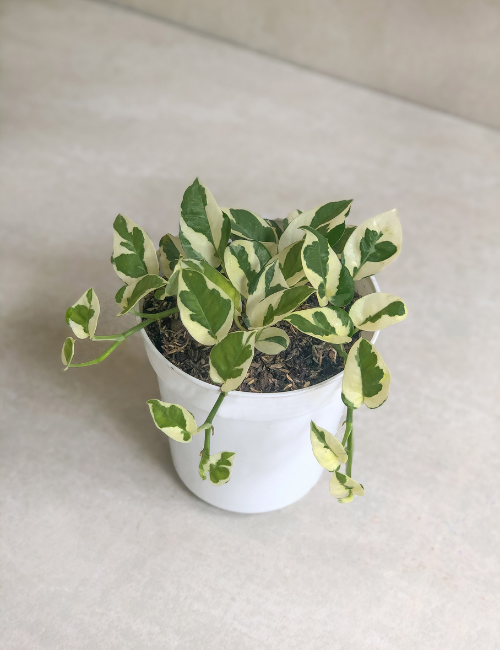 Pothos N'Joy. The tender leaves are fresh and are appealing, this plant unlike other pothos is not a fast grower, the color combination of so magnificent that you cannot move your eyes away from the plant. They love bright indirect light and no harm if exposed to morning sun but make sure that the plant is not exposed to harsh sun light as this may burn the leaves. 2-3 times a week. The Pothos N-joy grows best in moist soil be careful not to overwater it.
Pothos N'Joy. The tender leaves are fresh and are appealing, this plant unlike other pothos is not a fast grower, the color combination of so magnificent that you cannot move your eyes away from the plant. They love bright indirect light and no harm if exposed to morning sun but make sure that the plant is not exposed to harsh sun light as this may burn the leaves. 2-3 times a week. The Pothos N-joy grows best in moist soil be careful not to overwater it. -
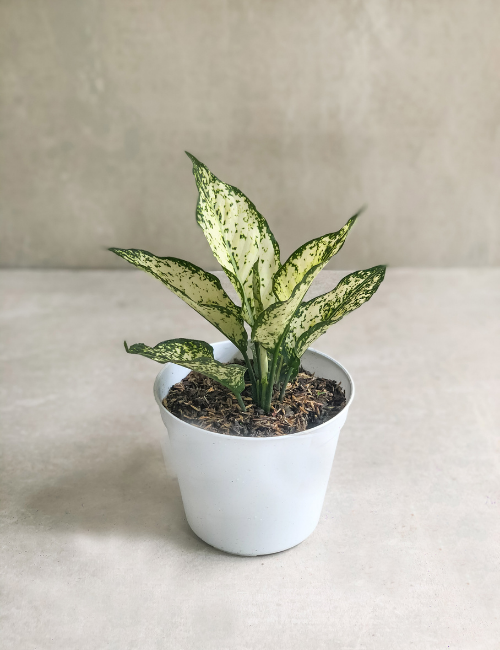 Aglaonema Snow White. Aglaonema, also known as Chinese Evergreen, is a highly decorative plant with several interesting varieties. It is one of the most popular houseplants and the colour variations—from dark green to silver, and some with hints of red—add to your home's decor. The darker green varieties of aglaonema can grow in near shade, while the variegated varieties require brighter light. Do not expose any variety of aglaonema to direct sun. 2-3 times a week, do not let the plant dry out completely.
Aglaonema Snow White. Aglaonema, also known as Chinese Evergreen, is a highly decorative plant with several interesting varieties. It is one of the most popular houseplants and the colour variations—from dark green to silver, and some with hints of red—add to your home's decor. The darker green varieties of aglaonema can grow in near shade, while the variegated varieties require brighter light. Do not expose any variety of aglaonema to direct sun. 2-3 times a week, do not let the plant dry out completely. -
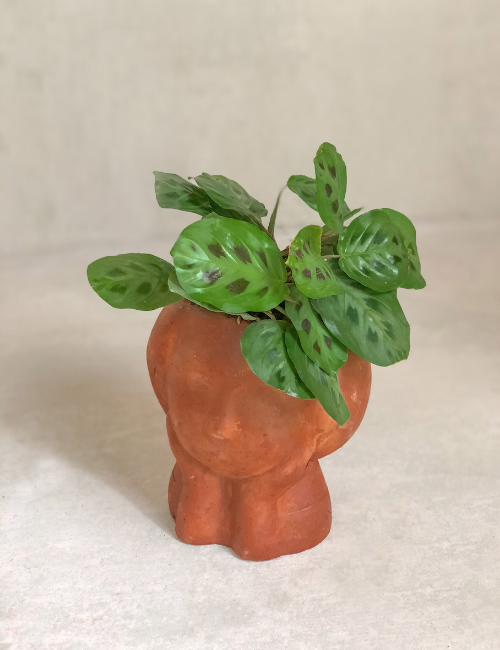 Calathea Maranta Leuconeura in Wonder Terracotta Calathea Maranta Leuconeura ‘Kim’ is a purple-spotted variety of prayer plant. Aside from the purple spots, the leaves have a cream-white streak for extra flair. Native to the tropical forests of Brazil, prayer plants are some of the most beautiful indoor houseplants you can find. They’re great in hanging baskets as they spread low and wide You can hang or set your prayer plant near a window where it will receive indirect sunlight. Never set your plant in direct sunlight because the sun will scorch the plant’s leaves or the leaves will develop blotches or patches and fade in color intensity. 2-3 times a week. Water the prayer plant when the top of the potting soil is just starting to become dry. These plants are very susceptible to drought; however, to avoid fungal problems, do not let water sit directly on the leaves or let the plant get soggy.
Calathea Maranta Leuconeura in Wonder Terracotta Calathea Maranta Leuconeura ‘Kim’ is a purple-spotted variety of prayer plant. Aside from the purple spots, the leaves have a cream-white streak for extra flair. Native to the tropical forests of Brazil, prayer plants are some of the most beautiful indoor houseplants you can find. They’re great in hanging baskets as they spread low and wide You can hang or set your prayer plant near a window where it will receive indirect sunlight. Never set your plant in direct sunlight because the sun will scorch the plant’s leaves or the leaves will develop blotches or patches and fade in color intensity. 2-3 times a week. Water the prayer plant when the top of the potting soil is just starting to become dry. These plants are very susceptible to drought; however, to avoid fungal problems, do not let water sit directly on the leaves or let the plant get soggy. -
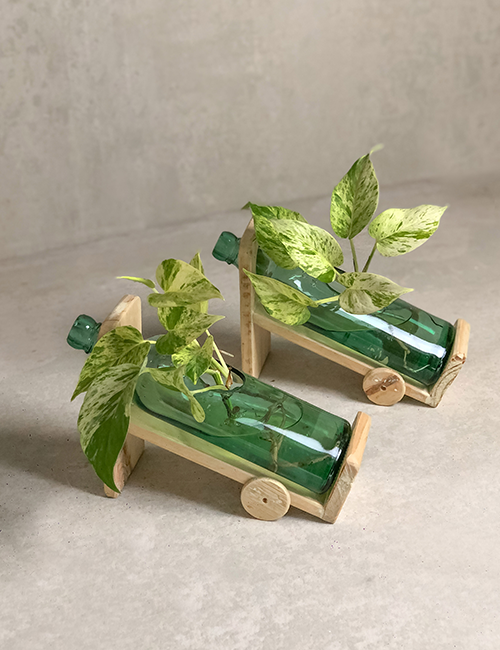 The pothos plant is considered by many to be a great way to get started caring for houseplants. Because pothos care in easy and undemanding, this lovely plant is an easy way to add some green in your home. To add up chic and unique essential to your home this Pothos in Recycle Bottle Frame will suit any corner and easy to care to just add water every 3- 4 days. Indoors, pothos prefers bright but indirect light. 3- 4 times a week, expect to water more often in brighter light and less often in lower light.
The pothos plant is considered by many to be a great way to get started caring for houseplants. Because pothos care in easy and undemanding, this lovely plant is an easy way to add some green in your home. To add up chic and unique essential to your home this Pothos in Recycle Bottle Frame will suit any corner and easy to care to just add water every 3- 4 days. Indoors, pothos prefers bright but indirect light. 3- 4 times a week, expect to water more often in brighter light and less often in lower light. -
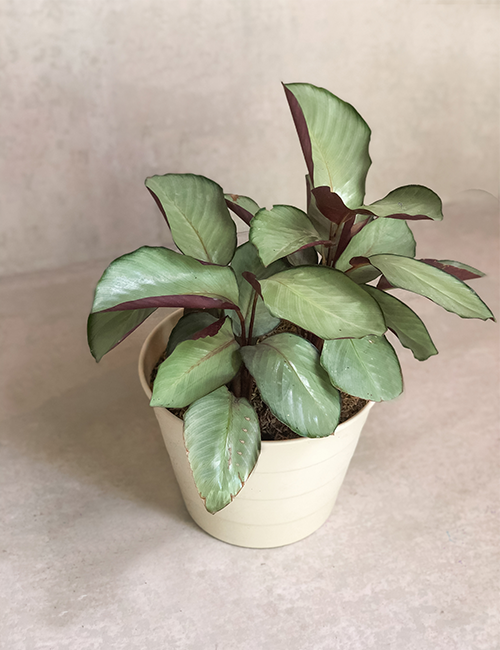 Calathea ‘Silver Plate’ has beautiful leaves which are uniformly glossy greenish-grey on top, purple below, sometimes with green margin, broadly ovate. Leaf stalks are purple that makes a wonderful indoor plant with decent look in your calathea collection. Bright but indirect light. Only water after Soil dries completely
Calathea ‘Silver Plate’ has beautiful leaves which are uniformly glossy greenish-grey on top, purple below, sometimes with green margin, broadly ovate. Leaf stalks are purple that makes a wonderful indoor plant with decent look in your calathea collection. Bright but indirect light. Only water after Soil dries completely
